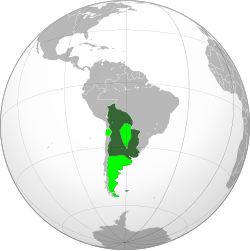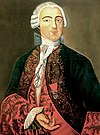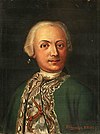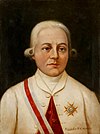Viceroyalty of the Río de la Plata
This articleneeds additional citations forverification.(January 2008) |
Viceroyalty of the Río de la Plata Virreinato del Río de la PlataorProvincias del Río de la Plata | |||||||||||||
|---|---|---|---|---|---|---|---|---|---|---|---|---|---|
| 1776–1825 | |||||||||||||
| Motto:Plus Ultra "Further Beyond" | |||||||||||||
| Anthem:Marcha Real "Royal March" | |||||||||||||
 Viceroyalty of the Río de la Plata andde jureextension (light green) | |||||||||||||
| Status | Viceroyaltyof theSpanish Empire | ||||||||||||
| Capital | Buenos Aires (1776–1810) Montevideo (1811–1814) | ||||||||||||
| Common languages | Spanish(official, administrative) Indigenous languages | ||||||||||||
| Religion | Roman Catholicism | ||||||||||||
| Government | Monarchy | ||||||||||||
| Monarch | |||||||||||||
• 1776–1788 | Charles III(first) | ||||||||||||
• 1813–1825 | Ferdinand VII(last) | ||||||||||||
| Viceroy | |||||||||||||
| History | |||||||||||||
• Organized | 1 August 1776 | ||||||||||||
| 1st– 2 January 1806 2nd– 3 February 1807 | |||||||||||||
| 25 May 1810 | |||||||||||||
| 28 September 1810 | |||||||||||||
• Fall ofMontevideo | 23 June 1814 | ||||||||||||
• Formally abolished after theCampaign of Sucre in Upper Peru | 1 April 1825 | ||||||||||||
| Currency | Spanish real | ||||||||||||
| |||||||||||||
TheViceroyalty of the Río de la Plata(Spanish:Virreinato del Río de la PlataorSpanish:Virreinato de las Provincias del Río de la Plata)[4][5]meaning "River of the Silver", also called the "ViceroyaltyofRiver Plate"in some scholarly writings, in southern South America, was the last to be organized and also the shortest-lived of one of theviceroyalties of the Spanish Empireinthe Americas.The name"Provincias del Río de la Plata"was formally adopted in 1810 during theCortes of Cádizto designate the Viceroyalty of the Río de la Plata.[6]
The Viceroyalty was established in 1776 from several formerViceroyalty of Perúdependencies that mainly extended over theRío de la Plata Basin,roughly the present-day territories ofArgentina,Chile,Bolivia,ParaguayandUruguay,extending inland from the Atlantic Coast.[7]The colony ofSpanish Guinea(present-dayEquatorial Guinea) also depended administratively on the Viceroyalty of Rio de la Plata.[8]Buenos Aires,located on the western shore of theRío de la Plataestuary flowing into the Atlantic Ocean, opposite the Portuguese outpost ofColonia del Sacramento,was chosen as the capital. Usually considered one of the lateBourbon Reforms,the organization of this viceroyalty was motivated on both commercial grounds (Buenos Aires was by then a major spot forillegal trade), as well as on security concerns brought about by the growing interest of competing foreign powers in the area. The Spanish Crown wanted to protect its territory againstGreat Britainand theKingdom of Portugal.
But theseEnlightenment reformsproved counterproductive, or perhaps too late, to quell the colonies' demands. The entire history of this Viceroyalty was marked by growing domestic unrest and political instability. Between 1780 and 1782, theRebellion of Túpac Amaru IIinspired a violentAymara-led revolt across theUpper Peruhighlands, demonstrating the great resentment against colonial authorities by both themestizoand indigenous populations. Twenty-five years later, theCriollos,native-born people of Spanish descent, successfully defended against two successiveBritish attempts to conquer Buenos Aires and Montevideo.This enhanced their sense of autonomy and power at a time when Spanish troops were unable to help.
In 1809, the Criollo elite revolted against colonial authorities atLa PazandChuquisaca,establishing revolutionary governments orjuntas.Although short-lived,retroversion of the sovereignty to the peopleprovided a theoretical basis for the legitimacy of the locally based governments (temporarily in the absence of a legitimate king in Spain). These events proved decisive at the 1810May Revolutionevents deposingViceroy Cisnerosat Buenos Aires.
The name"Provincias del Río de la Plata"was formally adopted in 1810 during theCortes of Cádizto designate the Viceroyalty[6]based onpopular sovereignty.The revolution in Buenos Aires spread across the Spanish Provincias del Río de la Plata, against the resistance ofParaguay(which declared itself an independent nation in 1811) and theUpper Peru(which remained controlled byroyalisttroops from Lima, and was eventually re-incorporated into the Viceroyalty of Peru). Meanwhile, the Governor of MontevideoFrancisco Javier de Elío,appointed as a new Viceroy by theSpanish Governmentin 1811, declared theBuenos Aires Juntaseditious. However, after being defeated atLas Piedras,he retained control only of Colonia del Sacramento and Montevideo. He departed by ship to Spain on 18 November and resigned in January 1812. In 1814, the revolutionary patriots entered Montevideo, following atwo-year-long siege.The Viceroyalty was disestablished in1825as Spanish political entity with the fall ofUpper Peruand the death of the last ViceroyPedro Antonio Olañeta.[9]
History[edit]

Origin and creation[edit]
In 1680, Manuel Lobo,PortuguesegovernorofRio de Janeiro,created theDepartment of Coloniaand foundedColónia do Sacramento.The fort was located on the coast of present-dayUruguayand developed as the department's capital. Lobo's chief objective was to secure thePortuguese expansion of Brazilbeyond the 1494Treaty of Tordesillas,which had defined areas of influence in the Americas between the Iberian nations. From 1580 to 1640, Spain had controlled Portugal and thus all of its territories in America. In 1681José de Garroquickly attacked and seized the new fort forSpain.On 7 May 1681, under theProvisional Treaty of Lisbon,it was ceded toPortugal.
TheViceroyalty of Peruwas requiring all commerce to go through the port ofLima,on the Pacific Ocean. This policy failed to develop the potential ofBuenos Airesas an Atlantic port, adding months to the transport of goods and commodities in each direction. It resulted in encouraging widespreadcontrabandactivities in the eastern region, especially inAsunción,Buenos AiresandMontevideo.
Under these conditions, ViceroyManuel de Amat y Junyentissued a decree for the formergovernor of the Río de la Plata,Pedro Antonio de Cevallos,to found the new viceroyalty in August 1776. The ruling was resisted by the elite of Lima, but it was enforced. The cabildo of theCaptaincy General of Chilerequested from the king to be excluded from the new viceroyalty, which was accepted.[10]TheCuyo region,with its main cityMendoza,was split from the Captaincy General of Chile. Leaders inSantiagoresented this action as the Cuyo region had been originally settled by Spanish colonists from Chile.
The Portuguese prime minister,Marquis of Pombal,encouraged the occupation of territory which had already been awarded to the Spanish in theTreaty of Paris (1763),following the British defeat of France in theSeven Years' War.KingCharles IIIquickly reacted to the advantageous conditions:Francewas bound to be an ally as a guarantor of the treaty, andGreat Britain,due to its own colonial problems with revolution in the Thirteen Colonies in North America, maintained neutrality on the issues between Portugal and Spain.
Pedro de Cevallos conquered Colonia del Sacramento and theSanta Catarinaislands after a siege of three days, gaining theFirst Treaty of San Ildefonso.With it, the Portuguese retired from the Río de la Plata and left theBanda Orientalfor Spain. In exchange Spain ceded them the area ofRio Grande do Sul,which they developed as Brazil. Cevallos ended his military actions at this point and started working with government, but he was soon replaced byJuan José Vertiz y Salcedo.The viceroyalty was tasked with promoting local production of linen and hemp as export commodity crops, to supply the Spanish cloth industries that the Bourbons sought to favor.[10]
The early viceroyalty[edit]
The conditions imposed by Spain on local commerce were high, but Charles III sought to lighten the burden. He allowed commerce through Buenos Aires on Spanish flag ships that were manned with Spanish naval officers. The ports of Buenos Aires and Montevideo were included in a list of Spanish ports allowed to trade with each other, certain Spanish American products were imported tax-free to Spain, and all the cities with ports were to be assigned Consulates or Tribunals of Commerce. This was notfree trade,but a predecessor to what would develop.[11]
In the decade of 1778–1788, the commerce between Spain and Spanish America increased by nearly 700%.[11]Buenos Aires was given a customs office in 1778, and Montevideo in 1789. Spanish policy still was directed at restricting Argentina commerce; the Empire banned the export of silver from Buenos Aires and tried to direct exports out ofPotosí.
The system ofcorregimientosto mark the subdivisions of the territory was ended in 1782, and replaced withIntendenciasby Charles III. The new system was intended to re-enforce the royal authority and promote centralization. Buenos Aires had the main intendencia, and the other cities provincial ones. In 1778 Cevallos reinstated theReal Audiencia of Buenos Aires,by creating a new one; he maintained the Real Audiencia atCochabamba.TheConsulate of Commerce of Buenos Aireswas authorized that year, but legal difficulties prevented its being established until 1794.
In 1766, Spain acquired the French colony on the Falkland Islands, calledPort St. Louis;after assuming effective control in 1767, it placed the islands under a governor subordinate to theBuenos Aires colonial administration.The expulsion of the British settlement in 1770brought the two countries to the brink of warbut a peace treaty allowed the British to return from 1771 until 1776, with neither side relinquishing sovereignty.[12]
Decline[edit]
By the nineteenth century, Buenos Aires was becoming more self-sufficient, producing about 600,000 head of cattle annually (of which about one quarter was consumed locally). The area was rapidly developing. But wars withGreat Britainmeant a great setback for the region's economy, as maritime communications were practically paralyzed. TheUpper Peruregion started to show resistance to continued support of the administration and defense of the Río de la Plataestuary;it provided the main support but its silver production at Potosí was declining. In the first years of the viceroyalty, around 75% of the expenses were covered with revenues from the north. The Alto Plata (mostly present-dayParaguay) also had problems with the Buenos Aires administration, particularly because of its keeping a monopoly on exports.
TheNapoleonic Warson the Continent preoccupied the Spanish government and, after its defeat, Napoleon placed his brotherJosephon the Spanish throne. By 1805, Spain had to helpFrancebecause of their 1795alliance,and lost its navy to the British in theBattle of Trafalgar.The Spanish prime minister had warned the viceroyalty of the likelihood of aBritish invasion,saying it could not provide support to the city of Buenos Aires.
On 27 June 1806, a British force of around 1,500 men underCol.William Carr Beresfordsuccessfully invaded Buenos Aires. ViceroyRafael de Sobremontehad escaped toCórdoba.The British forces were thrown back by thecriollosin December 1806, amilitiaforce from Montevideo under the leadership ofSantiago de Liniers.In February 1807, British reinforcements of about 8,000 men underGen.SirSamuel AuchmutycapturedMontevideoafter a fierce fight. In MayLt. Gen.John Whitelockarrived to take overall command and attacked Buenos Aires on 5 July 1807. After losing more than half his force, who were killed or captured, Whitelock signed a cease-fire and departed forGreat Britain.
The criollobourgeoisieaspirations in the face of lack of support fromSpainand the defeat of a world power by local forces added to their confidence and fueled their movement toward independence. As of 1814, Argentina had been self-governed for about four years, and Paraguay had already declared its independence. The viceroyalty was effectively dissolved locally when the rebel troops entered Montevideo after a two-year-long siege. The war remained in Upper Peru until 1825.
Government[edit]

TheViceroyaltyof the Río de la Plata was created in 1776 byCharles III of Spain.Although it functioned as a Spanish colony, Río de la Plata was technically a personal possession of theKing of Spain.This allowed both European Spain and its overseas territories to have their own laws and regulations.
Dependencies[edit]
- Intendency(Spanish:Intendencia) of Buenos Aires: cities ofBuenos Aires,Corrientes,Santa Fe,ColoniaandCarmen de Patagones.
- Government(Spanish:Gobernación) of Montevideo: city ofMontevideo.
- Government of Misiones: cities ofSan Ignacio,YapeyúandCandelaria.
- Intendency of Paraguay:city ofAsunción
- Intendency of Córdoba: cities ofRio Cuarto,Córdoba,La Rioja,San Juan,MendozaandSan Luis
- Intendency of Salta:cities ofCatamarca,Santiago del Estero,Tucumán,SaltaandJujuy
- Government of Chiquitos
- Intendency of Potosí: cities ofPotosíandOruro.
- Intendency of La Paz: city ofLa Paz.
- Intendency of Cochabamba: cities ofCochabambaandSanta Cruz de la Sierra.
- Intendency of Charcas:city of Charcas (modernSucre).
- Government of Moxos
List of viceroys[edit]
The king of Spain appointedviceroysto govern the Spanish viceroyalties in his name. In the beginning their terms had nofixed durationand could last for life. Later he established fixed terms of three to five years.[13]Because of the distances between Spain and South America, and with sailing as the chief means of transport, there were long delays between the designation of a viceroy and the viceroy's effectively taking power. In addition, regular communication between the Crown and the viceroyalty was equally delayed. The viceroyalties had to operate with considerable independence and self-reliance.
| # | Picture | Name | Term | Designation | Notes |
|---|---|---|---|---|---|
| 1 |  |
Pedro Antonio de Cevallos | 15 October 1777 – 26 June 1778 | 1 August 1776 | Appointed byCharles III of Spain |
| 2 |  |
Juan José de Vértiz y Salcedo | 26 June 1778 – 7 March 1784 | 27 October 1777 | Appointed byCharles III of Spain;resigned |
| 3 |  |
Nicolás del Campo | 7 March 1784 – 4 December 1789 | 13 August 1783 | Appointed byCharles III of Spain |
| 4 |  |
Nicolás Antonio de Arredondo | 4 December 1789 – 16 March 1795 | 21 March 1789 | Appointed byCharles IV of Spain,resigned |
| 5 |  |
Pedro Melo de Portugal | 16 March 1795 – 15 April 1797 | 5 February 1794 | Appointed byCharles IV of Spain,died in office |
| - | Real Audiencia of Buenos Aires | 15 April 1797 – 2 May 1797 | Interim government until the arrival of a new viceroy | ||
| 6 |  |
Antonio Olaguer Feliú | 2 May 1797 – 14 May 1799 | During his mandate, he had to contend with the presence ofBritishandPortugueseforces in the Río de la Plata region, as well as nascent revolutionary sentiment inspired by the recentFrench Revolution.He opened the port of Buenos Aires to foreign traffic in a bid to stimulate the commercial activities of the Viceroyalty. | |
| 7 |  |
Gabriel de Avilés, 2nd Marquis of Avilés |
14 March 1799 – 20 May 1801 | 25 October 1797 | |
| 8 |  |
Joaquín del Pino y Rozas | 20 May 1801 – 11 April 1804 | 14 July 1800 | Appointed byCharles IV of Spain,died in office |
| 9 |  |
Rafael de Sobremonte | 24 April 1804 – 10 February 1807 | 10 November 1804 | During theBritish invasions of the Río de la PlataBuenos AiresandMontevideofell under British authority for brief periods of time. Sobremonte was forced on 14 August 1806 by an open cabildo to move toMontevideo,delegating inSantiago de Liniersthe military authority and in the Audience the other areas of government. He was removed completely as viceroy by a martial court, with Liniers elected as interim viceroy.[14] |
| 10 |  |
Santiago de Liniers | 10 February 1807 – 30 June 1809 | Interim viceroy, confirmed in office byCharles IV of Spain,replaced by theJunta of Seville. | |
| 11 |  |
Baltasar Hidalgo de Cisneros | 15 July 1809 – 25 May 1810 | 11 February 1809 | Appointed by theJunta of Seville,ousted from office by theMay Revolution,replaced by thePrimera Junta. |
| 12 |  |
Francisco Javier de Elío | 19 January 1811 – January 1812 | 31 August 1810 | Governor of Montevideo, self-proclaimed "viceroy", political chief confirmed as such by theCortes of Cádiz,which also declared Montevideo the new capital of the viceroyalty and Buenos Aires a rebel city.[14] |
| 13 |  |
Pedro Antonio Olañeta | 27 May 1825 | 1825 | In May 1825, KingFerdinand VII of Spainappointed Pedro Antonio de Olañeta as viceroy of the Río de la Plata, unaware that he had died three months earlier at theBattle of Tumusla(Upper Peru).[14] |
See also[edit]
- List of governors in the viceroyalty of the Río de la Plata
- Argentine War of Independence
- United Provinces of the Río de la Plata
- History of Argentina
- History of Bolivia
- History of Paraguay
- History of Uruguay
- Spanish Guinea
- Viceroyalty of Peru
- Viceroyalty of New Granada
References[edit]
- ^Callao-Lima, Peru.United States. Bureau of Naval Personnel. 1920. p. 26.
- ^Lawrence, Sondhaus (2012).Naval Warfare, 1815–1914.p. 13.
- ^Von Tschudi, Johann (1847).Travels in Peru.p. 33.
- ^Beverina, Juan (1992).El virreinato de las provincias del Río de la Plata.
- ^Bel Ventura, Jaime (2012).España en América.Lulu. p. 267.ISBN978-1-4717-2693-4.
- ^abRoca, Eduardo (1999).América en el ordenamiento jurídico de las Cortes de Cádiz(in Spanish). p. 32.
- ^"Map of the Eastern Republic of Uruguay, 1893".World Digital Library.1893.Retrieved2013-10-24.
- ^"Guinea Ecuatorial".hubert-herald.nl.Retrieved2021-12-11.
- ^Friedman, Douglas (2019).The State And Underdevelopment In Spanish America.
- ^abAbad de Santillán, p. 195.
- ^abAbad de Santillán, p. 197.
- ^Lewis, Jason and Alison Inglis."A Brief History of the Falkland Islands: Part 2 – Fort St. Louis and Port Egmont"Archived2007-10-06 at theWayback Machine,Falklands Islands Information. Accessed 2007-09-08.
- ^"El Virreinato del Río de la Plata".Archived fromthe originalon 2009-10-15.Retrieved2009-12-05.
- ^abcVirreyes del Río de la PlataArchived2009-10-15 at theWayback Machine(in Spanish)
Bibliography[edit]
- Abad de Santillán, Diego.Historia Argentina(in Spanish). Buenos Aires: TEA (Tipográfica Editora Argentina).
- Lynch, John.Spanish Colonial Administration, 1782–1810: The Intendant System in the Viceroyalty of the Río de la Plata.London, University of London, Athlone Press, 1958.
External links[edit]
 Media related toViceroyalty of Río de la Plataat Wikimedia Commons
Media related toViceroyalty of Río de la Plataat Wikimedia Commons
- 1776 establishments in the Spanish Empire
- 1776 establishments in the Viceroyalty of the Río de la Plata
- 1814 disestablishments in Argentina
- 1814 disestablishments in the Spanish Empire
- 1814 disestablishments in the Viceroyalty of the Río de la Plata
- 1770s in Argentina
- 1780s in Argentina
- 1790s in Argentina
- 1800s in Argentina
- 1810s in Argentina
- Colonial Argentina
- Colonial Bolivia
- Colonial Paraguay
- Colonial Uruguay
- Former colonies in South America
- Former political divisions related to Argentina
- Former Spanish colonies
- History of South America
- Río de la Plata
- Spanish colonization of the Americas
- Spanish-speaking countries and territories
- States and territories disestablished in 1814
- States and territories established in 1776
- Viceroyalty of Peru
- Viceroyalty of the Río de la Plata
- Viceroyalties of the Spanish Empire


